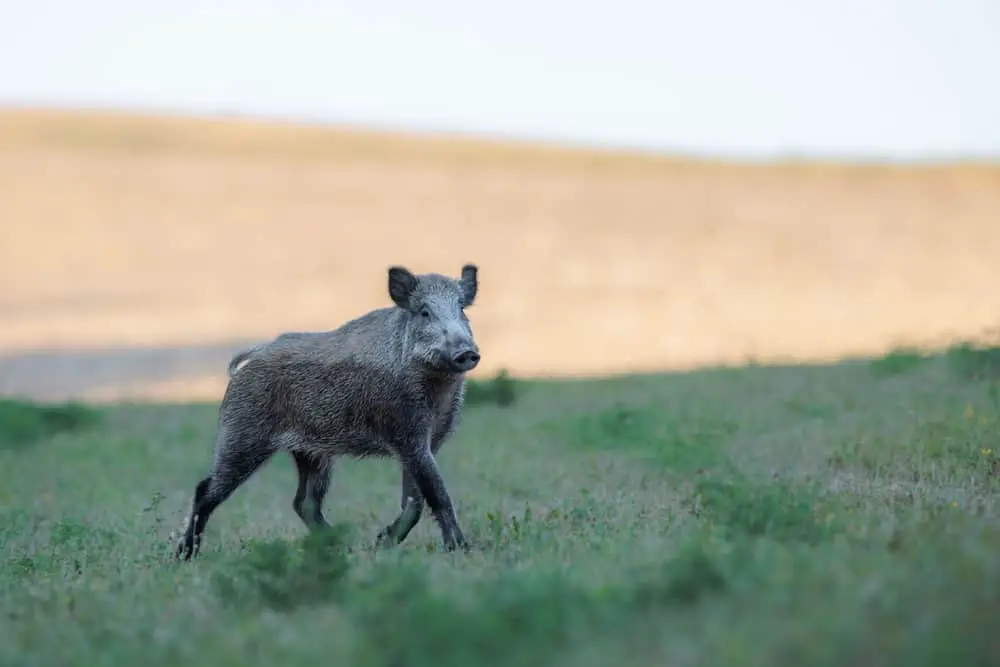Suidae, or the pig family, is a group of mammals that belongs to the order Artiodactyla.
This family includes domestic pigs (Sus scrofa domesticus), wild boars (Sus scrofa), and their relatives such as warthogs and babirusas.
Suids are distributed all over the world except for Australia and Antarctica. They are highly adaptable animals that can live in various habitats ranging from tropical rainforests to arid deserts.
Suids have been an important source of food for humans since ancient times. Domestication of pigs started at least 9,000 years ago in Asia and Europe, where they were used primarily for meat production.
Nowadays, pigs are one of the most widely raised livestock species worldwide due to their high productivity and versatility in terms of diet and environment. Wild boars also play an essential ecological role as seed dispersers and soil engineers in many ecosystems.
However, some populations have become invasive species causing significant damage to crops, forests, and native wildlife.
In this article, we will explore different aspects of suid biology including anatomy, behavior, ecology, evolution, conservation status, and interactions with humans.

Genus
- Genus Babyrousa – babirusa
- Genus Phacochoerus – warthogs
- Genus Hylochoerus – giant forest hog
- Genus Potamochoerus – bushpigs
- Genus Sus – typical pigs
- Genus Porcula – pygmy hog
Anatomy Of Suids
Suids are a family of mammals that belong to the order Artiodactyla. They are commonly known as pigs or hogs and can be found in various parts of the world, including Europe, Asia, Africa, and North America.
The internal organs of suids are similar to those of other artiodactyls but have some distinct features. For instance, their stomach is divided into four compartments: the rumen, reticulum, omasum, and abomasum. This division facilitates efficient digestion of plant matter by microbial fermentation.
Suids also have a distinctive skeletal structure characterized by a relatively large skull with a rounded forehead and short snout. Their limbs are adapted for running and rooting in the ground for food. Additionally, suids possess an elongated rostrum (nose) that helps them locate food using their sense of smell.
The dental formula of suids consists of 44 teeth used for grinding tough vegetation material. Overall, understanding the anatomy of suids is crucial because it provides insights into how they adapt to different environments and survive in diverse ecosystems without compromising their physiological functions.
The Babirusa’s Predators Revealed: Unmasking the Threats
Species
| Species Name | Scientific Name | Geographic Distribution |
|---|---|---|
| Wild boar | Sus scrofa | Europe, Asia, North Africa |
| Domestic pig | Sus scrofa domesticus | Worldwide |
| Vietnamese pot-bellied pig | Sus scrofa vittatus | Southeast Asia |
| Javan pig | Sus verrucosus | Indonesia |
| Bearded pig | Sus barbatus | Southeast Asia |
| Palawan bearded pig | Sus ahoenobarbus | Philippines |
| Philippine warty pig | Sus philippensis | Philippines |
| Visayan warty pig | Sus cebifrons | Philippines |
| Celebes warty pig | Sus celebensis | Indonesia |
| Sulawesi babirusa | Babyrousa celebensis | Indonesia |
| Togian babirusa | Babyrousa togeanensis | Indonesia |
| North Sulawesi babirusa | Babyrousa babyrussa | Indonesia |
| Pygmy hog | Porcula salvania | India, Nepal |
| Desert warthog | Phacochoerus aethiopicus | Africa |
| Common warthog | Phacochoerus africanus | Africa |
| Forest hog | Hylochoerus meinertzhageni | Central and West Africa |
| Red river hog | Potamochoerus porcus | West and Central Africa |
| Bushpig | Potamochoerus larvatus | Sub-Saharan Africa |
| Giant forest hog | Hylochoerus hydrochaeris | Central and West Africa |
Behavior And Social Structure
Suidae, or pigs, are known to have a complex social structure that is based on the dominance hierarchy. The dominant male pig or boar is responsible for leading the herd and mating with females during breeding season.
In addition, subordinate males will frequently engage in aggressive behavior towards each other as they attempt to establish their place in the hierarchy.
Communication methods also play an important role in suidae social behavior. Pigs use a variety of vocalizations to communicate with one another including grunts, squeals, snorts, and screams. These sounds can convey different messages such as aggression, fear, or contentment.
Additionally, body language is used by pigs to signal submission or dominance within the group. For example, submissive pigs may lower their heads or flatten their ears while dominant pigs will stand tall with erect tails.
Overall, suidae exhibit fascinating behaviors and social structures that warrant further study. Understanding these aspects of pig behavior can provide insight into not only how they interact with each other but also how they respond to changes in their environment and captivity conditions.
Ecology And Habitat Preferences
Suidae are a widely distributed family of mammals that inhabit various ecosystems, ranging from tropical rainforests to semi-arid grasslands. These animals have evolved specific adaptations that enable them to survive in diverse habitats.
Their preferred habitat is typically characterized by the presence of water sources such as rivers or wetlands, which provide essential resources for their survival.
Dietary habits vary across different species of suidae depending on their habitat preferences. For instance, forest-dwelling suids consume mainly fruit, while those inhabiting savannas and grasslands feed predominantly on grasses and other vegetation. Additionally, some species also supplement their diet with insects, small vertebrates, or carrion.
Reproductive strategies within this family are diverse but are generally influenced by environmental factors such as food availability and predation pressure. Female suids typically give birth to litters consisting of 2-8 piglets after a gestation period averaging around 115 days. The young remain dependent upon their mothers for several months before becoming independent adults.
Overall, the ecology and habitat preferences of suidae are intricately linked to their dietary habits and reproductive strategies. Understanding these relationships is crucial for conservation efforts aimed at preserving endangered populations of these fascinating animals worldwide.
Evolutionary History Of Suids
The evolutionary history of Suids is a fascinating and complex topic that spans millions of years. Through the fossil record, we are able to trace the lineage of this family back to the early Eocene epoch, where they first appeared in what is now Europe and North America.
Over time, these animals diversified into various forms, adapting to their environments and developing unique traits such as tusks and snouts for rooting. However, it was not until molecular phylogeny studies were conducted that researchers were able to fully understand the relationships between different suid species.
These studies have shown that some seemingly unrelated species actually share common ancestors, while others thought to be closely related are more distantly connected than previously assumed. It is through a combination of both fossil evidence and genetic analysis that we can paint a full picture of how suids evolved over time.
Further research in this field will undoubtedly uncover even more insights into the rich history of these remarkable animals. Through examination of the fossil record and advances in molecular phylogeny techniques, much has been learned about the evolution of Suids throughout history.
Despite our current understanding, there remains much work to be done in piecing together their complete story. As new discoveries continue to emerge from excavations around the world and technological advancements refine our ability to analyze DNA, there is no doubt that further revelations await us regarding this fascinating group of mammals.

Conservation Status And Threats
The Evolutionary History of Suids section illustrates how suidae have evolved and diversified over time.
However, despite their successful adaptation to various environments, several species are currently facing conservation challenges due to human activities such as deforestation, hunting, and habitat destruction.
These threats have resulted in population trends that indicate a decline in the numbers of certain suid species.
Conservation efforts for suidae must focus on mitigating these factors to ensure the survival of the affected populations.
This can be achieved through measures like protecting habitats from further destruction or fragmentation, regulating hunting practices, encouraging responsible tourism, educating local communities about sustainable resource use and engaging them in conservation programs.
Additionally, research into alternative livelihoods should be conducted so that communities that rely on wildlife resources can continue to meet their needs without compromising conservation goals.
It is important to address these challenges comprehensively to prevent extinction of suids and help maintain ecological balance within their respective ecosystems.
Human Interactions With Suids
Suids have shared a long and complex history with humans, dating back to the domestication of pigs in Asia around 10,000 years ago. The relationship between suids and humans has been shaped by various factors such as cultural practices, economic needs, and religious beliefs.
In this section, we will explore the different ways that human societies interact with suids.
- Domestication potential: One of the primary interactions between suids and humans is through domestication. Pigs are widely recognized for their high meat yield and fast growth rate, making them valuable livestock for many communities worldwide. This has led to selective breeding programs aimed at enhancing production traits such as litter size and feed conversion efficiency.
- Cultural significance: Another significant interaction between suids and humans is cultural significance. Across the world, pigs hold important symbolic value in celebrations and rituals. For example, during Chinese New Year festivities, families prepare pork dishes to symbolize wealth and prosperity.
- Hunting: Despite being domesticated animals, wild boars remain popular game species among hunters globally due to their challenging nature.
- Conservation efforts: Some organizations focus on preserving endangered pig species or subspecies through captive rearing or habitat restoration projects.
Overall, it is evident that suids play an essential role in human societies’ daily lives from food consumption to cultural practices. As we continue to learn more about these animals’ behavior patterns and genetics, there exists vast potential for further exploration into sustainable use and conservation strategies that balance ecological concerns alongside social and economic development goals without compromising future generations’ welfare.
Conclusion
Suids, commonly known as pigs, are a diverse group of mammals with unique anatomical and behavioral characteristics. Their anatomy includes a specialized snout for rooting in soil and obtaining food, robust bones to support their large body size, and four-toed hooves adapted for running and digging.
Suids exhibit complex social behaviors such as vocal communication, grooming, and forming close-knit family groups.
Suids are found in various habitats around the world including forests, grasslands, and wetlands. They have evolved over millions of years from small omnivorous ancestors into larger herbivores that play critical roles in ecosystem functioning.
Despite their ecological importance, many suid species face threats from habitat loss due to human activities such as agriculture and logging, hunting for meat or sport, and disease transmission from domesticated pigs.
As an old adage goes: ‘You don’t know what you’ve got until it’s gone.’ This phrase holds true for suids whose conservation status is becoming increasingly precarious.
It is crucial that we recognize the important role these animals play in maintaining healthy ecosystems and take proactive measures to protect them from further decline. Through responsible land management practices and targeted conservation efforts aimed at reducing anthropogenic impacts on wild pig populations, we can ensure that future generations will be able to appreciate the fascinating biology of suids.
